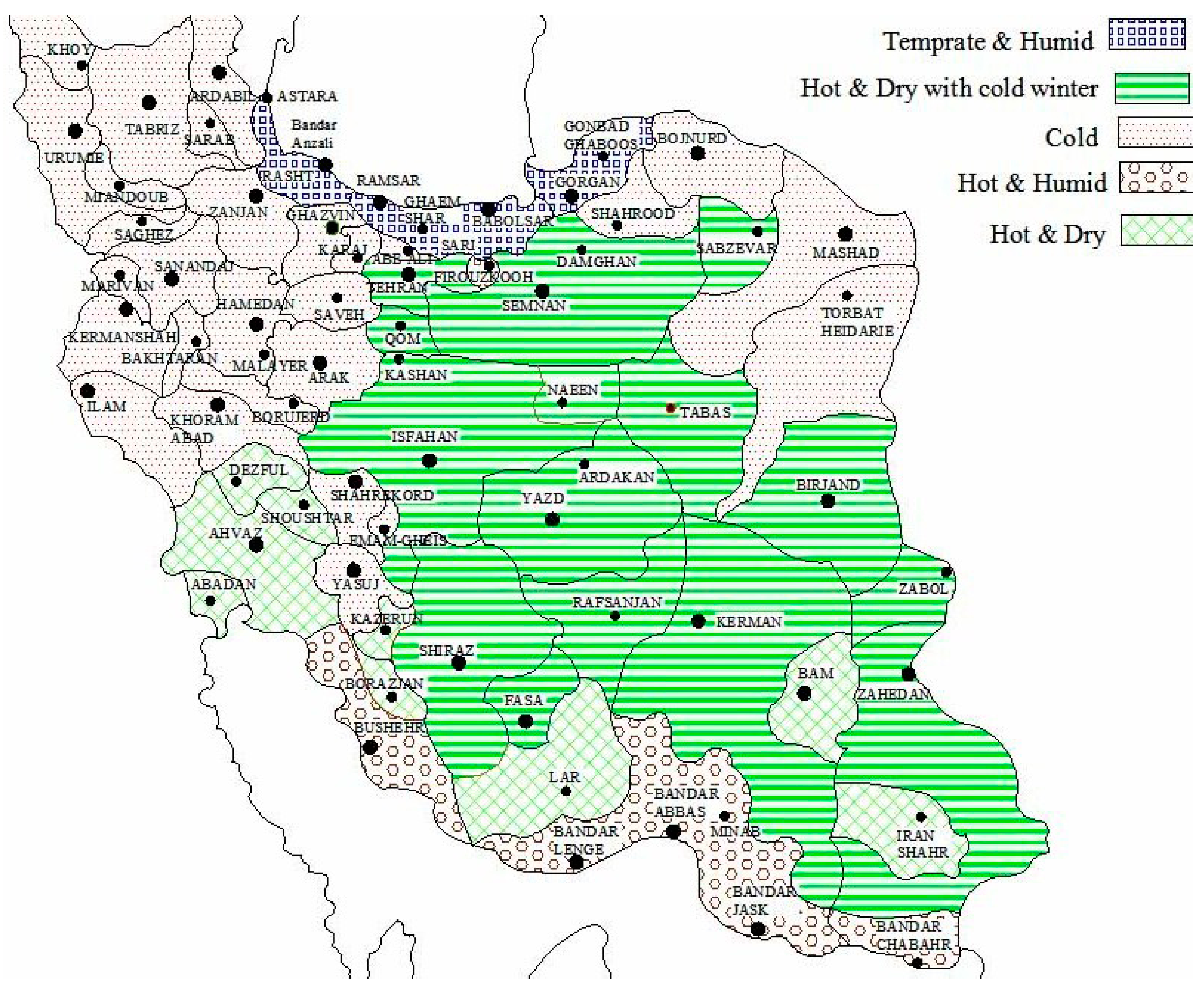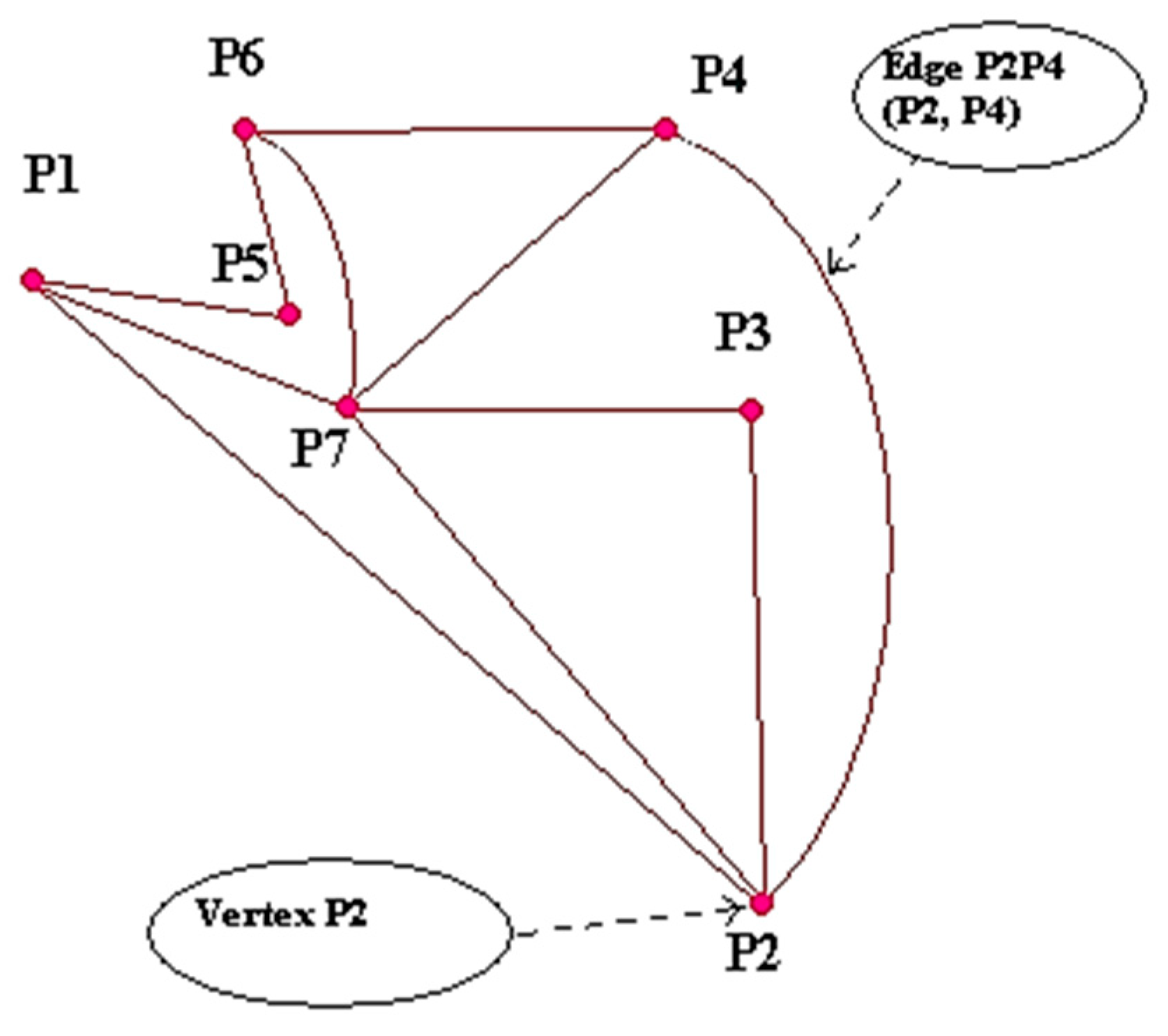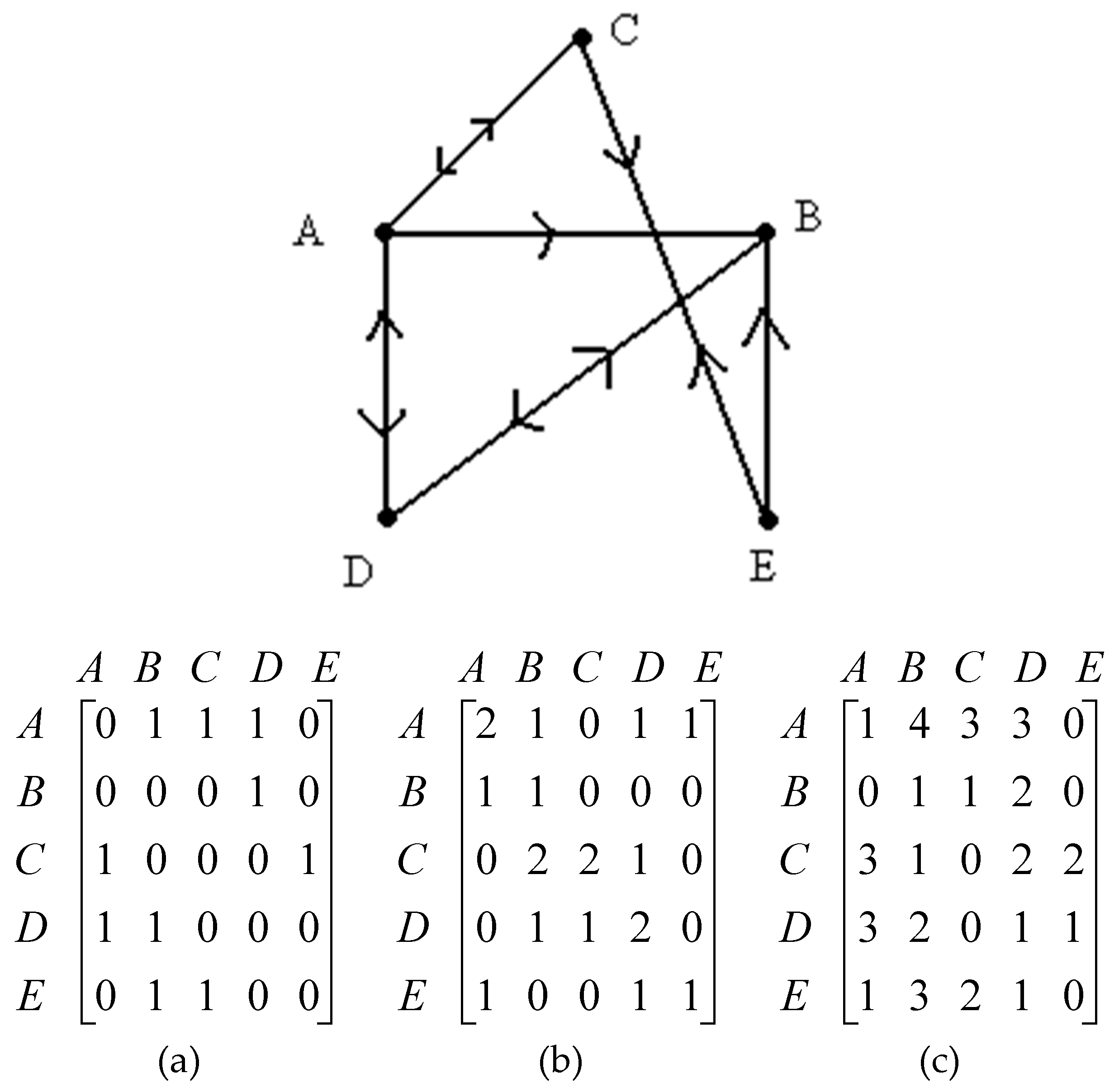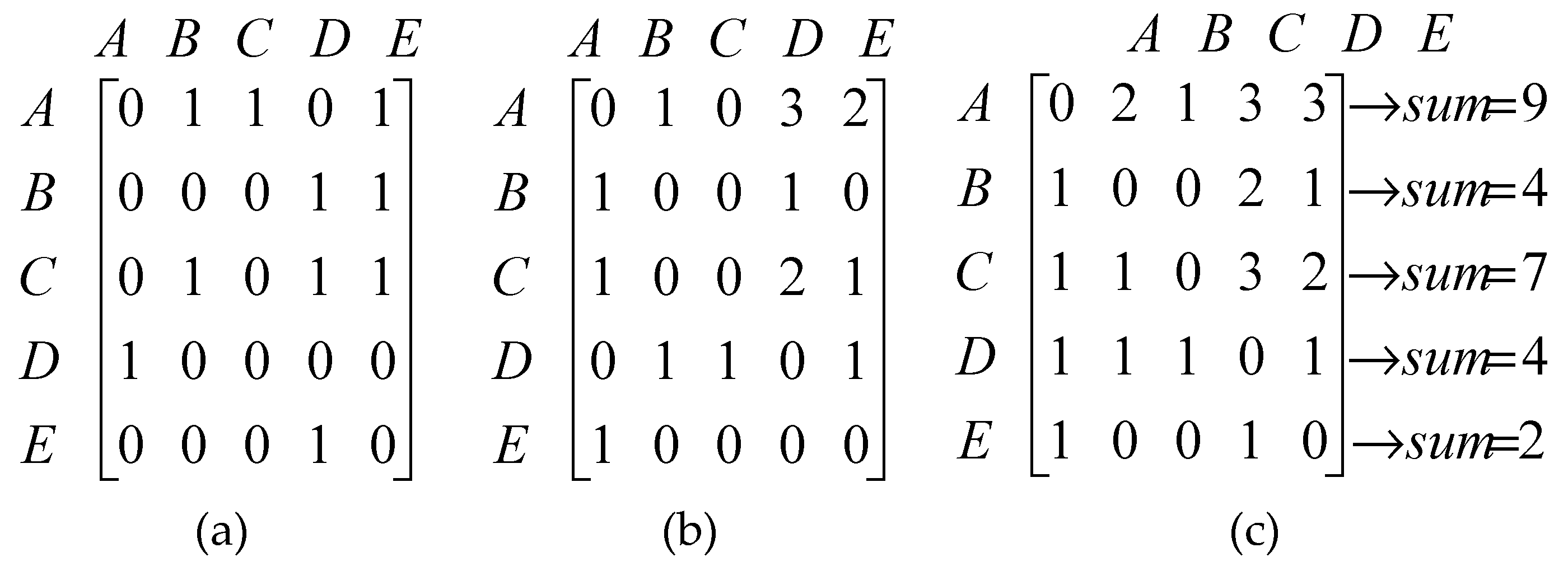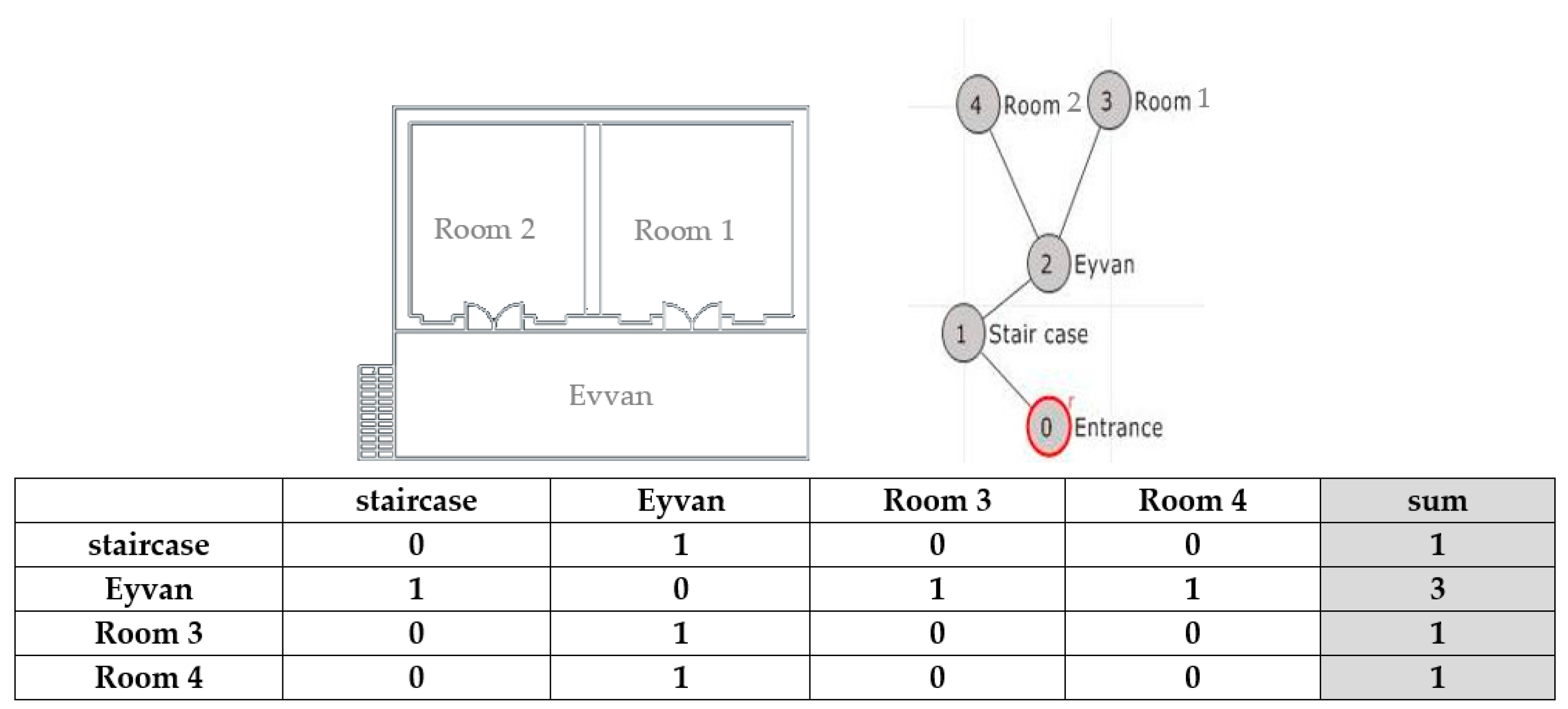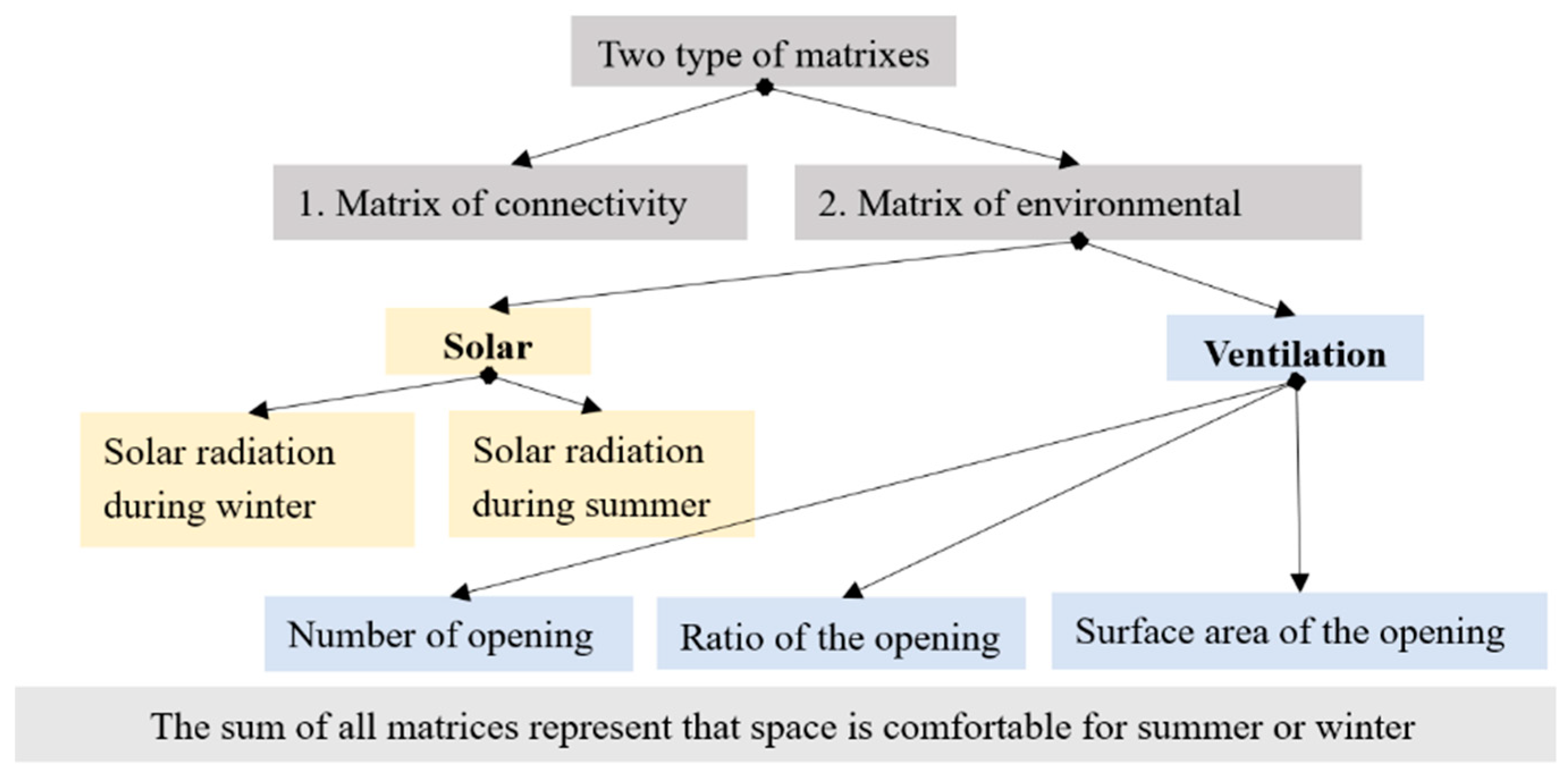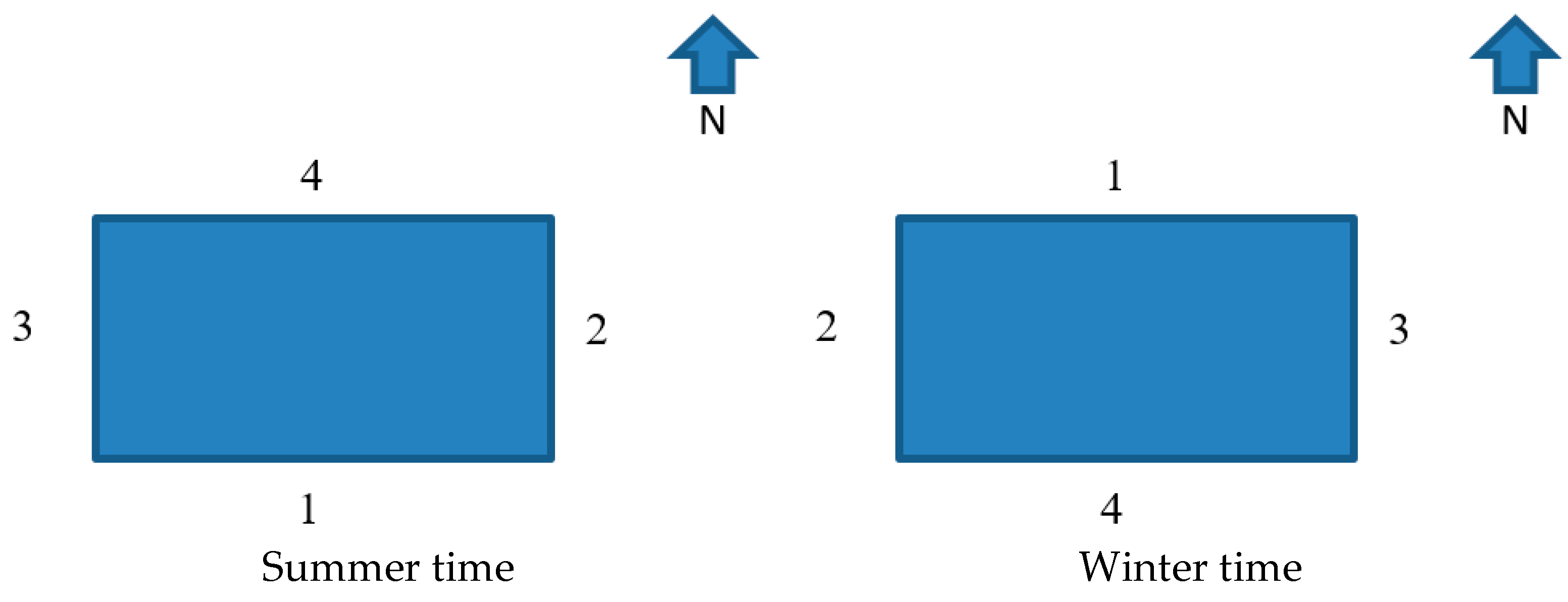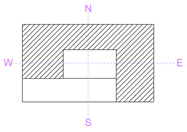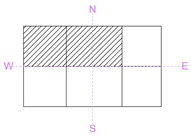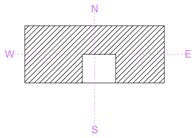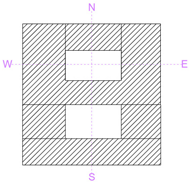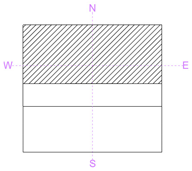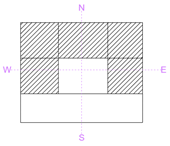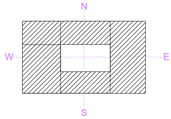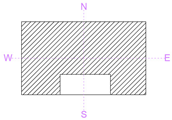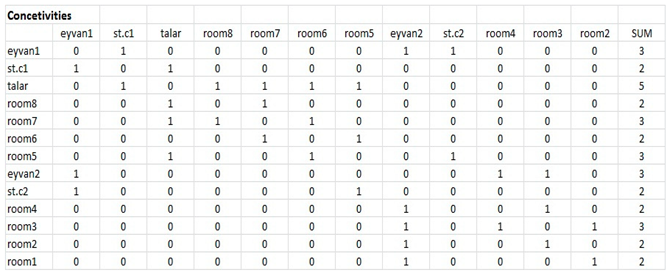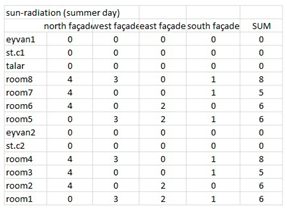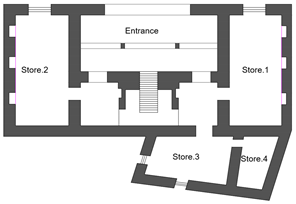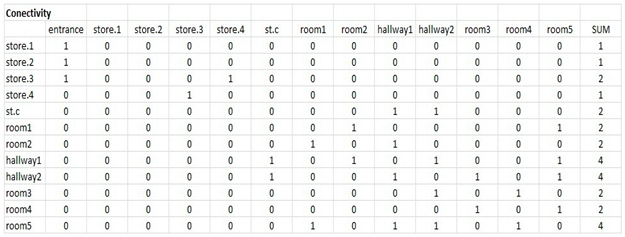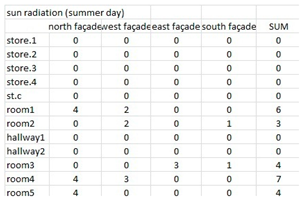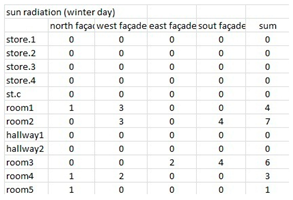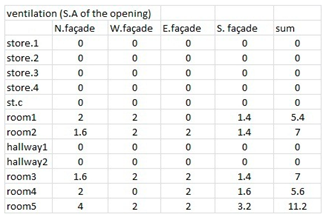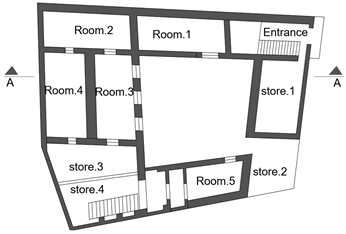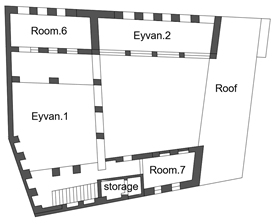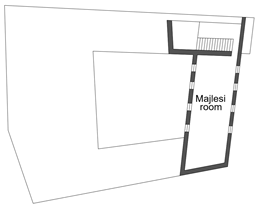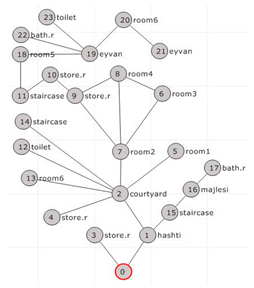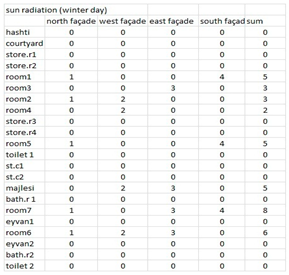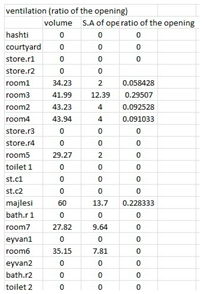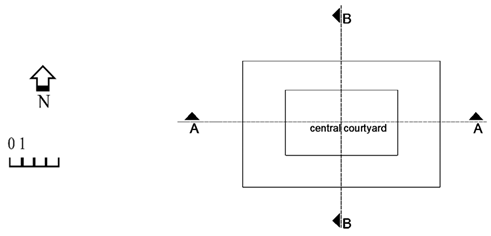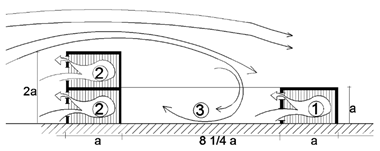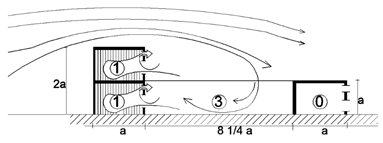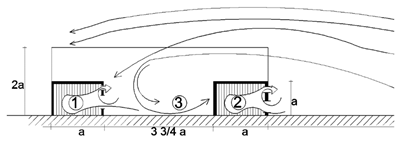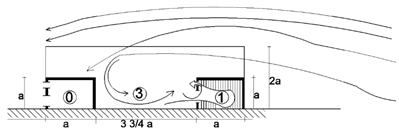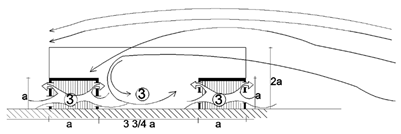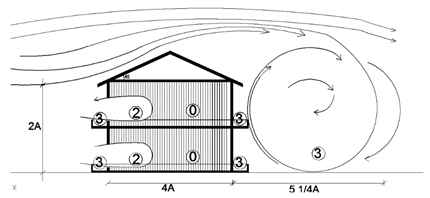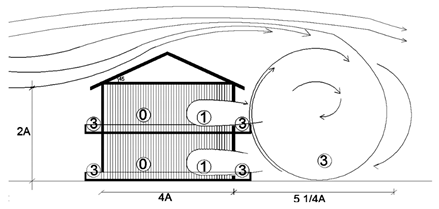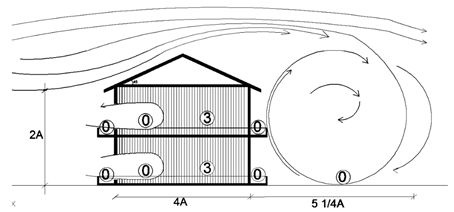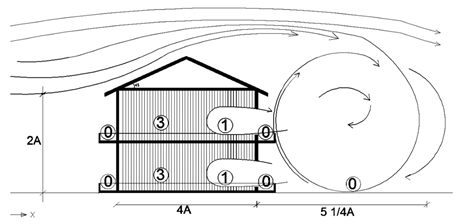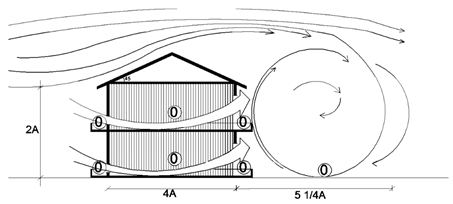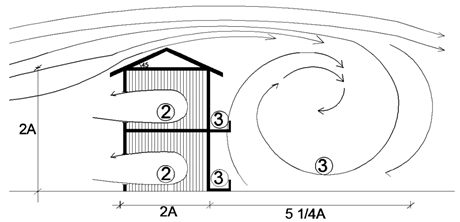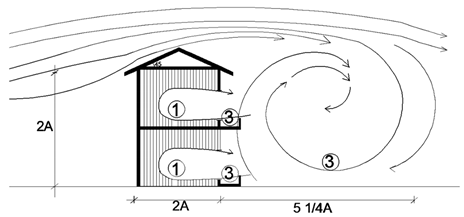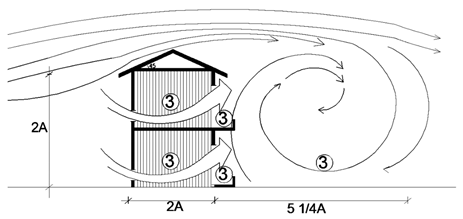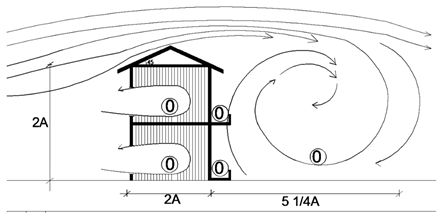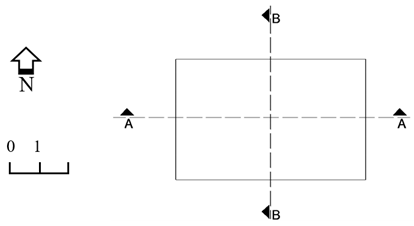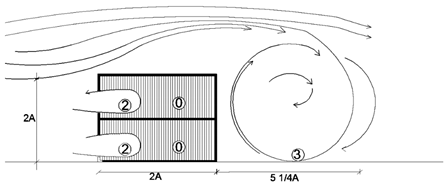1. Introduction
Human fulfillment and welfare are affected by the built environment. Hence, buildings need to give residents a sense of self-esteem, protection and confidentiality. Responding to nature is essential to maintain a healthy environment [
1]. Furthermore, the differentiation of climates all around the world requires altered designs and construction methods in order to create comfortable conditions for humans. Conversely, improvements in technology have become a reason to design contemporary buildings, without considering comfortable conditions. For instance, techniques for designing contemporary houses are the same in the different climatic zones of Iran. Psychological and physical discomfort are a problem that occurs due to a design arrangement that does not consider climatic conditions. However, using different design techniques in diverse climatic region in Iran brought about vernacular buildings that consider the well-being of the occupants in the past [
2].
People in Iran have adapted to their environment, and, in line with their religious beliefs, have applied the knowledge gained thereby to the construction of their houses. This correlation in the living environment in Iran was noted by Nasr, who proved its existence based on his observations of people’s actions and behaviors, aimed at ensuring their survival the inconsistent climate [
3], with seasonal movement being one such activity.
Accordingly, residents of traditional houses have sought to exploit the circulation of air and solar radiation during the coldest and hottest months of the year. In the more primitive accommodation of the nomads, seasonal movements, from cold regions to hot regions, and vice versa, cause changes based on location. Consistent with the type of house, seasonal movement is very extensive. For instance, seasonal movement occurs vertically in block houses [
4]. However, in courtyard houses, seasonal movement occurs horizontally around the courtyard, whereas during a hot day in summer, residents use low temperatures and cold weather. Hence, they move to the second floor or to the first or to the basement. It should be mentioned that, in the coldest months of the year, inhabitants preferred to stay in a room that has a smaller number of openings [
5].
Based on all these literature surveys, which signify the seasonal movement in Iranian traditional houses according to climate, the problem arises of when most Iranian contemporary buildings in different climatic region came to arrange spaces in the same way. Thus, what will happen in Iranian contemporary houses during the different seasons if the electricity is cut off for hours? Since residents in modern buildings have limited space, they cannot move horizontally or vertically between spaces for climate comfortability. Thus, the aim of this study is to use an easy graph and matrix method to create a sample model. The spatial arrangement of traditional Iranian buildings was adapted to the climate. This research attempts to examine the method in three case studies, located in the temperate-humid, hot-humid and cool climatic regions of Iran. Consequently, the main objective of this research is to assist architects with an easy method to design a modern building in consideration of climatic issues.
2. Climate and Space Organization
In Iran, space is the spirit of architecture. The presence of a ceiling, floor and walls dictates the degree of enclosure. Different kinds of spaces (open, semi-open and closed) can be found in buildings with different forms and dimensions, from the pre-Islamic through to the Islamic era. Closed spaces, semi-open spaces and open spaces are always formed concurrently, beside each other. Open spaces in traditional Iranian architecture provide a balance with the living room space in the enclosed part, creating a special organization. Thus, in traditional houses in Iran, semi-open spaces are one of the most significant elements [
6]. Furthermore, Haeri and Khanh mention that spaces are organized next to each other, based on the activities of the inhabitants in different seasons and at different times of the day. In historical Iranian houses, the organization of spaces needed to be flexible to accommodate variations in lifestyle [
7]. This research only focused on closed spaces, such as rooms, to understand comfortable climatic positions in a building during the seasons.
In traditional houses, the function of spaces is justified based on the daily activities and behaviors of the residents. There are a number of rules behind the manifestations of the function of spaces, such as: 1. Spaces are created based on the needs of the inhabitants, 2. Spaces are organized according to daily activities, 3. Corridors are organized as multi-functional spaces, 4. The principles of privacy in Iranian houses leads to a differentiation of spaces, and 5. Spaces are organized in such a way that the activities in one do not interrupt those in the others. Unfortunately, efforts in this regard in the present day have been unsuccessful in contemporary houses, mostly due to an inability to manage a significant organization, given the cultural issues associated with it [
8].
Additionally, ignoring climatic issues in the arrangement of spaces, both vertically and horizontally, in traditional Iranian houses is impossible. Najaf Abadi and Pakdaman have shown the organization of space around a central courtyard, based on the angle at which sunlight strikes the building. The inhabitants of central courtyard houses migrate vertically during the summer. In the summer, residents spend their time in the room that has a wind catcher until noon, when the weather becomes hotter, and then they migrate to the basement or cellar. The roof space is the best location at night, which is consequently designed in a beautiful and pleasant way, from a functional and climatic perspective. Moreover, horizontal migration takes place during the seasonal changes, between summer and winter. Residents, by migrating horizontally, make use of renewable energies for their needs, thus reducing the use of non-renewable energies [
9].
Seasonal movements in the temperate-humid region of Iran involve relocation to the ground floor in winter, where there are fewer openings, meaning more warmth is retained [
5]. The first floor is the place for summer spaces, where winds could provide comfort to the inhabitants. The ground floor of some traditional buildings contains spaces that are called
eyvan. Eyvan is the most significant circulation section during winter and summer time. It also serves as a small enclosed courtyard during winter time. The aforementioned examples of different traditional buildings proved that the segregation of spaces during the coldest and hottest months of a year could be influenced by climate. During the hottest months of a year, spaces are more closely joined to each other, whereas other spaces are separated, while in the coldest months, the isolated spaces may become integrated.
In addition, Naghabi conducted research on the traditional buildings in Tabriz city, where cool climatic conditions prevail. In her research, it was stated that in buildings with a central courtyard plan, the living room is most often positioned in the front, facing south. Furthermore, south-, east- and west-facing are the best orientations for positioning private rooms, since they receive light from the south. The kitchen and storage in these kinds of traditional buildings are located on the basement floor, and bedrooms are most often positioned on the upper floor. In order to use the east or west light spaces in introverted buildings, plans are oriented from north to south. Avoiding sun radiation in summer causes the living room and Eyvan to have a proper depth and position in the south side of the courtyard. However, rooms in building without a central courtyard face the south to obtain the required light. These kinds of buildings have windows all around [
10]. Moreover, based on the literature survey, the position of spaces in plans has a relation with climate comfort in traditional Iranian buildings. Thus, this research conducted the analysis on fifteen traditional houses that are located in three different climatic regions in Iran, and this is based on a previous study by the author that divided Iran into five different climatic regions (
Figure 1), being hot-humid, temperate-humid, cool, hot-dry with a cold winter, and hot-dry [
11]. Furthermore, in that study, the author identified that traditional architecture in Iran is constructed based on climatic conditions. Hence, this study focused on the arrangement of the spaces based on the solar gain and ventilation in the three climatic regions: Temperate-humid, cool and hot-humid.
Table 1 demonstrates the plan of fifteen traditional buildings. The author indicates that closed living spaces, with a hatch to determine the orientation of the common space arrangement between traditional buildings, are located in the same climatic context. The choice of a traditional building was made based on the common plan in all climatic regions.
The plans of traditional buildings in the same climatic region demonstrated similarities. In the hot-humid climatic region, most spaces in traditional buildings are positioned all around the central courtyard. Additionally, in the cool climatic region, facing to the south is a common orientation for the spaces in this region. In addition, case studies in the temperate-humid climatic region revealed that positioning spaces from east to west is something that houses have in common. Thus, this study graphically analyzed the three traditional buildings, selected from the fifteen that were analyzed (
Table 1), which was based on the literature survey space organization, and generally, their design was affected by climatic factors. Graphics is fast and easy to use, compared to intricate climatic evaluation tools, because it can transfer complicated plans into a simple graph. Consequently, the author makes use of a graph theory and the matrix analysis method, considering the two environmental factors of solar gain and ventilation. Before beginning the analysis, however, the basic concepts of graph theory, matrix analysis and Agraph are explained to reveal the applicability of the method for the field of architecture.
4. Scrutinizing the Graph Theory and Matrix Analysis Through Case Studies
In the first step, an access graph was drawn using AGRAPH software to comprehend the connections between the different spaces in the building. In the second step, the environmental analysis, the environmental issue is classified into three main categories, being solar radiation, ventilation and openings (
Figure 9). All of the environmental analyses are carried out according to the matrix calculation, for which a different kind of justified matrix is suggested, such as the connectivity matrix and another, related to the environmental matrix.
This research considers two different types of winter and summer day calculations for solar radiation. Accordingly, for the summer time, a value of four is defined for the north façade, three for the west façade, two for east façade and one for south façade, while in the winter, the values are reversed, meaning four for the south façade, two for the west façade, three for the east façade and one for north façade (
Figure 10). Thus, all of the values resulting from these environmental solar radiation analyses will be between one (worse) and four (best).
In the following stage, a ventilation matrix analysis is carried out for three different categories, being the number of openings and the surface area of the openings on the different façades, from which the ratio of the openings can be found independently for each space.
It is significant to state that in the present research, the matrix calculation is focused only on enclosed spaces, such as rooms, and so for the environmental researches, the values of spaces other than rooms are considered to be zero. Finally, the sum of the matrices for solar radiation during summer and winter, and also those for ventilation based on the number and the ratio of openings, are used to calculate all of these analyses with connectivity, which are found from the access graph, reaching a conclusion that can demonstrate the summer and winter spaces. Spaces with values below eighteen can be considered winter spaces, and those with values greater than eighteen can be considered summer spaces. In the following section, an analysis is conducted of three traditional buildings in different climatic regions of Iran, illustrated with access graphs and matrix analyses.
In the following, an analysis of the three selected traditional buildings, represented in
Table 2,
Table 3 and
Table 4, is conducted for the provinces of Gilan (temperate-humid), East Azerbaijan (cool) and Hormozgan (hot-humid).
Based on the findings of the matrix analysis, it was concluded that the sum of the spaces with values greater than eighteen could be considered summer spaces, while those with values lower than eighteen could be considered winter spaces. Hence, this research found that the sum of the spaces, represented by room2, room3 and room6, are considered winter rooms, which are used during the cold season, and room1, room4, room7 and room8 are considered summer room, which are useful during the hot period of the year.
The matrix analysis indicates an interesting outcome, i.e., the sum of all the rooms is less than eighteen. The result indicates that room1, room2, room3, room4 and room5 can be considered winter spaces, for use during the cold seasons. There is no summer space in the traditional building located in the cool climate, since it is hot in this region for just two months of the year.
Finally, the matrix analysis indicates that room1, room2, room3, room4 and room5 are considered winter spaces. In addition, room6, room7 and the Majlesi (guest’s room) are used during the hottest month of a year.
The analysis up to this point was based on the plan (two-dimensional). The investigation of the section (three-dimensional) of a building will complete the method. Consequently, this study has also identified the optimum number and location of openings in the building fabric for the best ventilation during summer and winter for each of three climatic regions in Iran.
Consistent with previous studies by the author, and making use of SMART techniques, a value of zero indicates the worst thermal comfort condition, while a value of three indicates the best thermal comfort condition. Furthermore, the author also identified, in a previous study, the direction of the prevailing wind in the five climatic regions [
21] and carried out a ventilation analysis. It should be noted that this study also considered the ratio between the width, length and height of the traditional building’s section. From another point of view, a justified number, defined based on the wind shadow and the effect of it on the building its surrounding, was considered.
Donald and Kenet (1983) [
22] verified that for a flat and sloppy roof, understanding the length of the wind shadow depends on the building’s dimension in terms of width, height and length. The dimensions of the building affected the wind shadow, since it is adjusted to the wind speed and direction. This study conducted the analysis on the section of Iranian traditional buildings by concentrating on the table provided by Donald and Kenet (
Table 5).
Consequently, the justified number, identified for each of the three climatic regions, is consistent with the wind direction and geometrical shape of the traditional building and number and place of the openings. For example, in
Table 6, which represents a traditional building in the hot-humid climatic region, where the height of the building was measured as “2a,” and the width as “a,” the wind shadow will continue until 8 ¼ a. Hence, spaces located in the wind shadow could get the highest justified number of three during summer time. In addition, most traditional buildings in the hot-humid climatic region have an upper window as well. The reason for this upper window is that it conducts the warm air, since it has a low weight, in comparison to the air outside. Furthermore, cooler air will pass from a lower window through the spaces of a building. Consequently, the room with an opening on both facades could obtain the highest justified number three. Additionally, the space that has just one opening toward the wind direction could obtain the justified number of two. It should be mentioned that all these justified numbers will be reversed during winter time.
Table 6,
Table 7 and
Table 8 show the optimum and least beneficial number and locations of the openings in the hot-humid, cool and temperate-humid climatic districts of Iran during winter and summer time. In addition, to present the best section sample in relation to natural ventilation, the drawing is based on the majority of traditional building types in each specific climatic region.
5. Result
Based on the graph theory and matrix analysis, the result confirmed that rooms positioned on the first floor are comfortable during summer, and those on the ground floor are suitable during winter, in traditional buildings located in the temperate-humid climatic region. The result is the same as that found in Ghobadian’s research (2006), who mentioned that residents adjust themselves in the temperate-humid climatic region by moving vertically during different seasons [
23]. In addition, Memarian (2006) illustrated that seasonal movement in central courtyard houses occurred around the boundary of a courtyard [
19]. Most traditional buildings in the hot-humid climate have a central courtyard. However, in this climatic region, seasonal movement occurred both vertically and horizontally. For instance, in this case study, the rooms on the ground floor received a sum result of less than eighteen, while those positioned on the mezzanine and first floor have a sum of more than eighteen. Subsequently, the first floor is the comfortable place, and it can also take advantage of the wind during the hottest months of a year. In addition, the result for the cool climatic region confirmed that, under harsh cool climatic conditions, the outcome of all the rooms is lower than eighteen, meaning that there is no need for seasonal movement during summer time. In a previous study [
11], the author indicated that there are two months of the summer period with a temperate temperature in the cool climatic region. Additionally, rooms are mostly located on the first floor to make use of the warm temperature from the ground floor’s function, which is mostly for cattle, kitchen or storage. Consequently, all three traditional buildings matched the literature survey.
Hence, this research could conclude that the matrix analysis and graph theory could provide the proper result, since seasonal movement in these traditional buildings proved to be correct. Thus, by considering the spatial arrangement of fifteen traditional buildings in three climatic regions of Iran, this study was able to propose the best and most comfortable spatial arrangement sample, based on solar gain, for the hot-humid, temperate-humid and cool climates in Iran (
Figure 11).
Consistent with the analysis, the best spatial arrangement in the temperate-humid and cool climatic region was found to be the one that is extended from east to west to obtain the best solar radiation during the winter and summer periods. A section analysis in the temperate-humid and hot-humid climates demonstrated that to obtain the best ventilation during summer, the building stories should have two stories because of the temperate and humid climatic conditions. In addition, the position of the opening, for decreasing the humidity in both the hot-humid and temperate-humid climates, should be in the direction of the wind. In the hot-humid climate, it is recommended that the building plan be the one that is surrounded around a central courtyard. The best position of the opening in this climate is on the top and bottom of the façade, in order to allow cool wind to enter from the bottom window and warm wind to exit from the top window. Moreover, in the cool climatic region, the sample model should protect the building from wind. Hence, a smaller number of openings to the wind is recommended. In the case of a number of stories, for instance, a two-story building, the ground floor should warm the upper floor. The best form of the plan in this climatic region is both with and without a central courtyard. For instance, in the case of a building without a courtyard, to obtain the best advantage of solar radiation during the coldest months of the year, most rooms should be positioned on the northern side.
